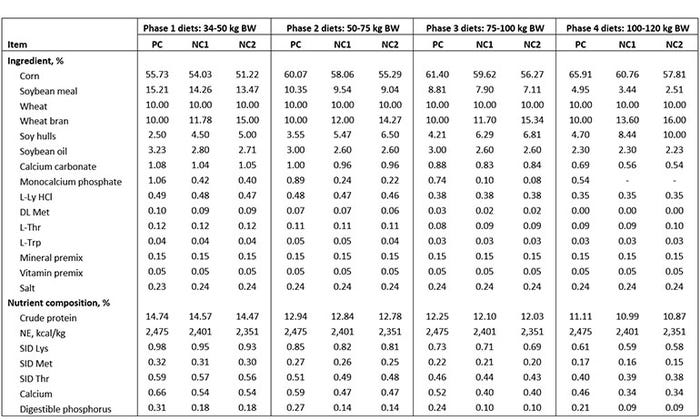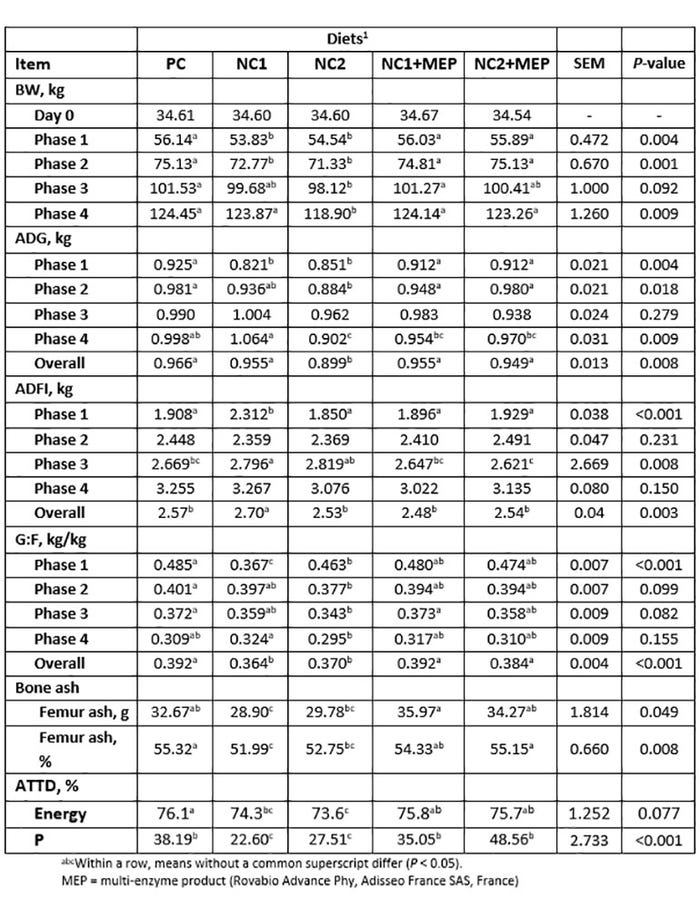Net energy, SIDAA and P can be lowered by about 5% in MEP-supplemented diets without negative effects on growth performance and bone strength of pigs.
May 21, 2020

Corn and wheat grains, and their co-products, are the most widely used sources of energy in swine diets. However, these feedstuffs contain phytate and fiber that reduce nutrient utilization. Undesirable effects of phytate and fiber can be alleviated through dietary supplementation of phytase and fiber-degrading enzymes. The most abundant types of fiber in wheat and corn are arabinoxylans that are composed of xylans (a sugar that creates the backbone of arabinoxylans) and arabinose units (the sugars that link to and create branches off the xylan backbone).
The enzymes that breakdown xylans are known as xylanases, whereas those which break down the arabinose branches are known as arabinofuranosidases (debranching enzymes). While xylanase and arabinofuranosidase act on different substrates, their combined supplementation efficiently degrades arabinoxylans, making each enzyme group more effective and valuable in simple and complex diets.
In swine production, supplementing corn- or wheat-based diets with xylanase has reported positive effects. However, there is a lack of information on the combined effects of xylanase and arabinofuranosidase on the nutrient utilization in pigs fed corn-wheat-based diets.
A study at South Dakota State University evaluated the effects of supplementing a multi-enzyme product (xylanase, glucanase, arabinofuranosidase and phytase; supplied by Adisseo France SAS) on the growth performance, bone strength and nutrient digestibility of growing pigs fed corn-wheat-wheat bran-based diets that were low in nutrient density. Criteria measured included average daily gain, average daily feed intake, gain-to-feed ratio, bone strength (femur ash) and nutrient digestibility (apparent total tract digestibility of energy and phosphorus).
A total of 276 pigs with initial body weight of 34 kilograms were housed in 45 pens of six or seven pigs, blocked by gender and weight, and fed five diets (nine pens per diet). Diets consisted of a positive control and two negative controls (NC1 and NC2) that were supplemented without or with the MEP. The MEP supplied at least 1,800, 1,244, 6,600 and 1,000 units of xylanase, β-glucanase, arabinofuranosidase and phytase per kilogram of diet, respectively. The PC diet was adequate in all nutrients, and had greater digestible P content than NC1 or NC2 diet by 0.134 percentage points (Table 1).

Additionally, the PC diet had a higher net energy and standardized ileal digestible amino acid content than the NC1 diet (74 kilocalories per kilogram; 3% SIDAA) and NC2 diet (124 kcal/kg; 5% SIDAA). The diets were fed in four phases based on bodyweight; Phase 1: 34-50 kg, Phase 2: 50-75 kg, Phase 3: 75-100 kg, and Phase 4: 100-120 kg. Nutrient digestibility and bone mineralization were determined at the end of Phase 1.
For the overall study period (34-120 kg bodyweight), pigs fed the PC and NC1 diets did not differ in ADG and ADFI (Table 2); however, pigs fed the PC diet had greater ADG and G:F than those fed the NC2 diet. Pigs fed the PC diet had greater bone ash content and ATTD of P than those fed the NC1 diet. The ATTD of energy for the PC diet was greater than that for the NC1 or NC2 diet.

Supplementing the MEP did not affect ADG for pigs fed the NC1 diet, but it increased the ADG for pigs fed the NC2 diet by 5.09%. Supplementing the NC1 and the NC2 diet with the MEP increased G:F, bone ash content and ATTD of energy and P. The ADG, bone ash content and ATTD of energy and P for the MEP-supplemented diets were similar to the PC diet. Thus, net energy, SIDAA and P can be lowered by about 5% in MEP-supplemented diets without negative effects on growth performance and bone strength of pigs.
Sources: Kevin Jerez-Bogota, Maamer Jlali, Pierre Cozannet, Aurélie Preynat and Tofuko Woyengo, who are solely responsible for the information provided, and wholly own the information. Informa Business Media and all its subsidiaries are not responsible for any of the content contained in this information asset.
You May Also Like



